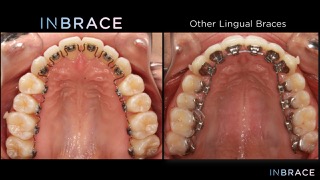What Are INBRACE Lingual Braces?

Long Beach, CA – Today, nearly one in five orthodontic patients is an adult. And with more adults seeking out orthodontic treatment, it’s no surprise that we’re seeing an increase in patients looking for more aesthetically pleasing options.
Aesthetically Pleasing Options: Lingual Braces
One of these options that is gaining in popularity is lingual braces. These braces consist of brackets and wire just like traditional braces, except they are placed on the lingual, or tongue side, of the teeth. Many adult orthodontic patients are hesitant to undergo treatment because they fear it will only draw unwanted attention to something they may already be self-conscious about. Lingual braces offer the same efficiency as traditional braces, but without the conspicuous brackets and wires.
Lingual Braces: INBRACE
If you’ve heard the name INBRACE, you’ve heard the name of the newest and most technologically advanced brand of lingual braces. IINBRACE can be used to treat a host of orthodontic issues, from mild to moderate, and even more severe, malocclusions. And all of this can be done discretely, unlike other options. INBRACE marries the effectiveness of conventional braces with the aesthetic quality of traditional lingual braces and the ease and comfort of aligners.
Just like traditional braces, lingual braces rely on the use of an archwire anchored to brackets on the teeth to guide the teeth to their ideal locations. INBRACE is unique because rather than using elastic ties to hold the wire in the brackets, their brackets use a small clip to hold the wire in place. This makes wire insertion and removal significantly easier and quicker for the patient and orthodontist. One of the major drawbacks of traditional lingual braces is the difficulty with placing and removing ties on the brackets, and the subsequent extended chairtime for the patient. INBRACE has taken away these obstacles to make the experience better for everyone involved.


INBRACE Vs. Invisalign
For those interested in aesthetic orthodontic treatment, the two best options available are lingual braces and Invisalign. One of the downsides of clear aligner therapy, such as Invisalign, is that it requires a high degree of patient compliance to ensure the treatment stays on track. Patients have to wear the aligners at least 22 hours a day to ensure the teeth move according to the orthodontist’s plan. But with INBRACE, your orthodontist places the appliance, and then you’re set! You don’t have to remember to take it out when eating, drinking, brushing and flossing, and you don’t have to remember again to put it back. And, instead of changing out your aligners for a new set every two weeks, your appliance will simply be adjusted at each of your orthodontic appointments.
INBRACE Disadvantages
No orthodontic appliance is without disadvantages, so it is important that we do address the two main concerns with INBRACE. First, dietary restrictions are still in force as the lingual braces could become loose if any hard/sticky/chewy/crunchy foods are eaten, similar to traditional braces. Second, there is a period of accommodation that the tongue will need to get used to the lingual appliance. It typically takes a week for patients to adjust to the new appliance with regard to eating, speaking and overall tongue comfort. To help ease this transition, we do a conditioning appointment for our patients three weeks before delivery of INBRACE. The conditioning appointment consists of bonding a few small metal buttons to the lingual of the lower posterior teeth. This allows the tongue to get used to having something on the inside of the mouth before a full mouth of lingual braces are placed.
HD Orthodontics offers a host of orthodontic treatment options to fit every patient’s aesthetic concerns, as well as their budgets.
To learn more about treatment options that might be right for you, call HD Orthodontics today at 562-283-6590.

